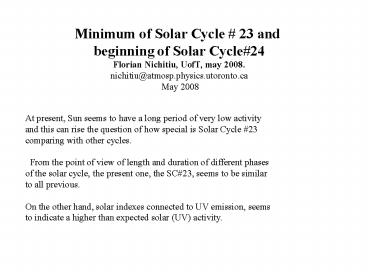Minimum of Solar Cycle - PowerPoint PPT Presentation
1 / 7
Title: Minimum of Solar Cycle
1
Minimum of Solar Cycle 23 and beginning of
Solar Cycle24 Florian Nichitiu, UofT, may
2008. nichitiu_at_atmosp.physics.utoronto.ca May
2008
At present, Sun seems to have a long period of
very low activity and this can rise the question
of how special is Solar Cycle 23 comparing with
other cycles. From the point of view of length
and duration of different phases of the solar
cycle, the present one, the SC23, seems to be
similar to all previous. On the other hand,
solar indexes connected to UV emission, seems to
indicate a higher than expected solar (UV)
activity.
2
The value of length of the Solar Cycle seems to
have no trend, but their variations,the cycle to
cycle total cycle lengths, are reducing.
The SC24 will not have probably an anomalous
length.
3
- It is also observed some opposite trends for the
length of - the two phases of solar cycle
- the Rise to Max length of the solar cycle
is decreasing while - the Fall to Min of the solar cycles is
increasing
4
Taking into account that the last minimum (of
SolCycle22-SolCycle23) was around 1996.5 and
the expected Rise to Max length of SolCycle23
is around 4 years, the max of SolCycle23 was
around middle of year 2000 which is practically
coincident with the first max recorded (in the
table below we have used different solar indices
to find out the time of the two maxims and the
Gnevyshev gap). Max 1
Gnevyshev min Max 2 SSN
2000.30732 2001.15286 2001.95708 Sun
Spot Number MgII 2000.51939 2001.15286
2002.12784 Core-to-wing Mg II index F10.7
2000.43401 2001.11154 2002.12784 Solar
Radio Flux 10.7 cm. SSAtot 2000.05394
2001.07023 2002.25453 Solar Spot
Area With an expected 7.5-8 years for the
descending phase of SC23 and if we take as
correct solar max 2000.5, we can expect to wait
only another few months up to the real solar min
SC23-SS24, or in other words up to beginning of
SC24 (we are now at the end of May 2008). So,
SC23, from point of view of temporal parameters,
is not a special cycle, as these parameters are
in the expected limits.
5
The well known relation Radio Flux (F10.7 cm)
vs. Sun Spot Number, seems to be different only
for this last Solar Cycle. More radio flux
per sun spot during Solar Cycle 23 (than in
previous solar cycles) and even more,
on its descending phase.
F10.7 gt SSN (from linear relation F10.7 vs SSN
) This is happened exactly after the Gnevyshev
(gap) minimum
6
During SC23 descending phase MgII index is
bigger than in previous cycles, and also bigger
than radio flux at 10.7cm
MgII gtgt F10.7
7
During SC23 descending phase
F10.7 gt SSN (from linear relation F10.7 vs SSN
) MgII gtgt F10.7 At the end of SC23,
Solar UV activity is higher than expected
It is this in coincidence with low sun spot
activity ?

